The Legal Framework for the Prohibition of the Chemical Weapons in Armed Conflicts: Syria became a member of the Chemical Weapons Convention(CWC) on October 14, 2013, after the Eastern Ghouta chemical attack on August 21, 2013, which resulted in the deaths of hundreds of civilians with hundreds more being exposed to the gas. As such, Syria is bound by the convention that stipulates that all states shall refrain from:
-
Developing, producing, acquiring, and stockpiling any chemical weapons or transporting them – directly or indirectly- to any state or organization.
-
Using the chemical weapons.
-
Conducting any military preparation with the aim to use the chemical weapons.
-
Assisting or encouraging any parties to conduct prohibited activities under this convention.[1]”
The CWC also requires the creation of an independent and technical Inspection Committee in the Technical Secretariat with a mandate to investigate allegations concerning the use of chemical weapons. Once the Committee finds out that a State Party has violated the CWC, the Inspection Committee has the right, among other things, to “Restrict or suspend the rights and privileges of the State Party, on the recommendation of the Executive Council, until the necessary procedures are carried out to make it adhere to its commitment[2]. In addition, when dangerous situations occur: “To refer the case, including the findings and information, to the UN General Assembly and the UN Security Council.”[3]
Additionally, the prohibition of the chemical weapons in international and non-international armed conflicts has become a customary rule under the International Humanitarian Law.[4] For example, the Rome Statute establishing the International Criminal Court stipulates that use of chemical weapons, the “employing asphyxiating, poisonous or other gases, and all analogous liquid, materials or devices[5]”, amounts to a war crime.
Based on the above, using chemical weapons amounts to war crime and those responsible can be held accountable, in such courts or tribunals. For this reason, those responsible for such crimes being committed within Syria must be held accountable.
Prohibition of Applying Chemical Weapons and the Syrian Conflict
The International Independent Investigation Commission about Syria (COI), which was established by the Human Rights Law Committee (HRLC) on August 22, 2011, pursuant to resolution S-17/1 which was adopted at the seventh exceptional session- stated in Article 128 of its seventh report released on February 12, 2014, that “the perpetrators have an accession to the chemical weapons stockpiles operated by the Syrian military.”[6] Referring to the chemical attacks that happened in some East Ghouta towns and al-Mo’adamya on August 21, 2013.
The UN Security Council, on September 27, 2013, passed Resolution 2118 in favor of the Executive Council’s resolution of the Organization for Prohibition of Chemical Weapons (OPCW), which includes special measures to accelerate the elimination of the Syrian chemical weapons program and subject it to a strict investigation. The Resolution 2118, stated measures to be imposed, under the Seventh Chapter of the United Nations Charter, in the situation that Syria does not comply with this resolution (No.21). In addition, the resolution required that Syria would not to use, develop, manufacture, acquire, stockpile, or possess any chemical weapons (No. 4). The resolution also declared no party within Syria should use chemical weapons (No. 5). Most importantly, the resolution also stipulated the need to hold accountable those responsible for applying chemical weapons in Syria (No. 15).
The “Joint Inquiry” by the Organization for the Prohibition of the Chemical Weapons (OPCW) and the United Nations released the fourth report on October 21, 2016, which stated that the Syrian government forces and the Islamic State, also known as ISIS, had used chemical substances as weapons. The joint inquiry had been conducting investigations concerning nine different occasions in Syria, and found out the use of chemical weapons in four incidents: Talmanas on April 21, 2014; Sarmin on March 16, 2015; Qamin on March 16, 2015, and (Mare’ on August 21, 2015. The report stated that the Islamic State in Iraq and the Levant, ISIS, was involved in using Mustard gas in Mare’ city, in the north countryside of Aleppo, while the Syrian government used poisonous chemical substances as weapons in Talamans on April21, 2014; Sarmin on March 16, 2015; and Qamin on March 16, 2015.
The UN Security Council, in the Resolution 2209 in 2015, condemned in the strongest terms the use of chemical poisonous substances like chlorine gas as a weapon, and stressed that all responsible individuals must be held accountable, as well as threatened to impose measures in case the Syrian government increased the use of chemical substances. Fourteen council members voted in favor of the resolution, including Russia, while Venezuela abstained.
On February 28, 2017, Russia, China, and Bolivia voted against any resolution imposing sanctions on the Syrian government for using chemical weapons. Egypt, Kazakhstan, and Ethiopia abstained. However, nine UN council members voted in favor of the resolution. Despite the failure of the resolutions to impose UN sanctions, the Joint Inquiry reports and the UN Security Council resolutions encouraged some countries to use their local laws and impose sanctions unilaterally. For example, the U.S. blacklisted 18 senior officials connected to the country’s chemical weapons program[7].
Several Syrian organizations on April 7, 2017, released a press statement in which they strongly condemned the developments in the Syrian armed conflict and the aerial attacks on Khan Sheikhoun, located in the south countryside of Idlib, on Tuesday April 4, 2017, when the Syrian regime used indistinctive weapons that amount to weapons of genocide. The organizations called for activation of provisions of the CWC, and for the UN to begin work under Resolution 2118 and Article 7 to intervene to protect civilians and prevent the recurrence of internationally banned weapons.
The Executive Council of the Organization for the prohibition of Chemical Weapons (OPCW) met on April13, 2017 to address the Khan Sheikhoun chemical attacks and expressed its concerns about the charges of using chemical weapons. It stated that the Inspection Committee is collecting information and evidence for analysis. The Committee agreed to reconvene April 20, 2017 to address the findings[8].
Methodology
Following the Khan Sheikhoun attack in Idlib province on Tuesday, April 4, 2017, Syrians for Truth and Justice (STJ) along with the Justice for Life Organization established a field research team [9] tasked with entering the city and inspecting the impact sites. In addition, they were tasked with collecting material evidence and accounts of the survivors, such as the injured and their families, as well as the accounts of eyewitnesses, such as medical staff and Civil Defense team members.
Given the intensive airstrikes the days after the attack, the field research team was obliged to enter the city on Sunday, April 9, 2017, according to a plan developed based on who was to be interviewed and how to gain as much information as possible about the attack. Beyond face-to-face interviews, additional individuals were also interviewed on-line. (The date and the method of each interview will be mentioned throughout this report.)
The research team also analyzed dozens of video tapes and images, especially those of images of the casualties and the injured, to verify the credibility of the materials as well as to check the symptoms that appeared on the wounded or the dead. Finally, the research team reviewed the forecast for the day of the attack in order to determine the wind patterns and the areas that might have consequently been affected by the chemical gases.
The following report is based on this methodology and includes over fifteen (15) accounts from survivors, surviving family members, eyewitnesses, as well as local experts.
Challenges
The research team faced severe challenges in completing its tasks. There was intensive airstrike on Khan Sheikhoun following on the initial attack on Tuesday, April 4, 2017. The different military-controlled zones, and the logistic and security challenges each posed, also made progress difficult. In addition, efforts at collecting testimonies and identifying the dead and injured took place in the midst of the terrible psychological situation facing the survivors and victim’s families, many of whom were still coming to terms with the catastrophe and the extensive number of victims.
Another challenge was determining the correct number of victims, dead or injured, due to:
-
the number of displaced people from other areas of the country that were also killed or wounded, making it difficult to check the identity of all casualties.
-
the documented cases where people treated their relatives without transferring them to medical centers or the Civil Defense Centers, leaving these centers unable to count all of the victims.
-
the close to thirty critically injured individuals that were transferred to Turkey, producing conflicting news reports concerning the actual number of the casualties.
-
the significant number of victims, dead or wounded, coupled with the city’s medical centers inability to receive such large numbers of patients, resulted in victims being transferred to other towns and cities, making it very difficult to make direct contact with them.
Finally, the research team found it difficult to confirm the hypothesis that other rockets may have contained poisonous chemicals and not just the first rocket that fell near the grain silos. This hypothesis was based on testimonies of residents who were near the strike locations as well as the relatively light scale of the destruction compared to other thermobaric weapons. Yet, the blowing of the north-south wind supported the hypothesis that only the first rocket contained poisonous chemicals as people were affected hundreds of meters away. Further study will have to be done to determine what actually occurred.
Preface
The Khan Sheikhoun attack on Tuesday, April 4, 2017, was second in scale to only the chemical attack on Eastern Ghouta in the Damascus countryside and al-M’adamya on August 21, 2013.
“Khan Sheikhoun is a town and a sub-district of Maarat al-Nu’man district in Idlib province. It is 37 km away from Hama province, 110 km away from Aleppo province and 70 km away from Idlib province. Khan Sheikhoun is located on the main highway between Aleppo and Damascus, and on a strategic road near other Syrian cities. As of 2004, it had a population of (52,972) according to the Central Bureau of Statistics (CBS).”
After repeated waves of displaced individuals from other towns and cities, due to the ongoing war, Khan Sheikhoun’s population grew to 63,000. It declined to 45,000 after the chemical attack on April 4th, 2017. The number of the internally displaced individuals (IDPs) reached 12,500 prior to the attack, whereas 7,400 were displaced after the attack to the north another areas across Syria, according to sources such as the local City Council.
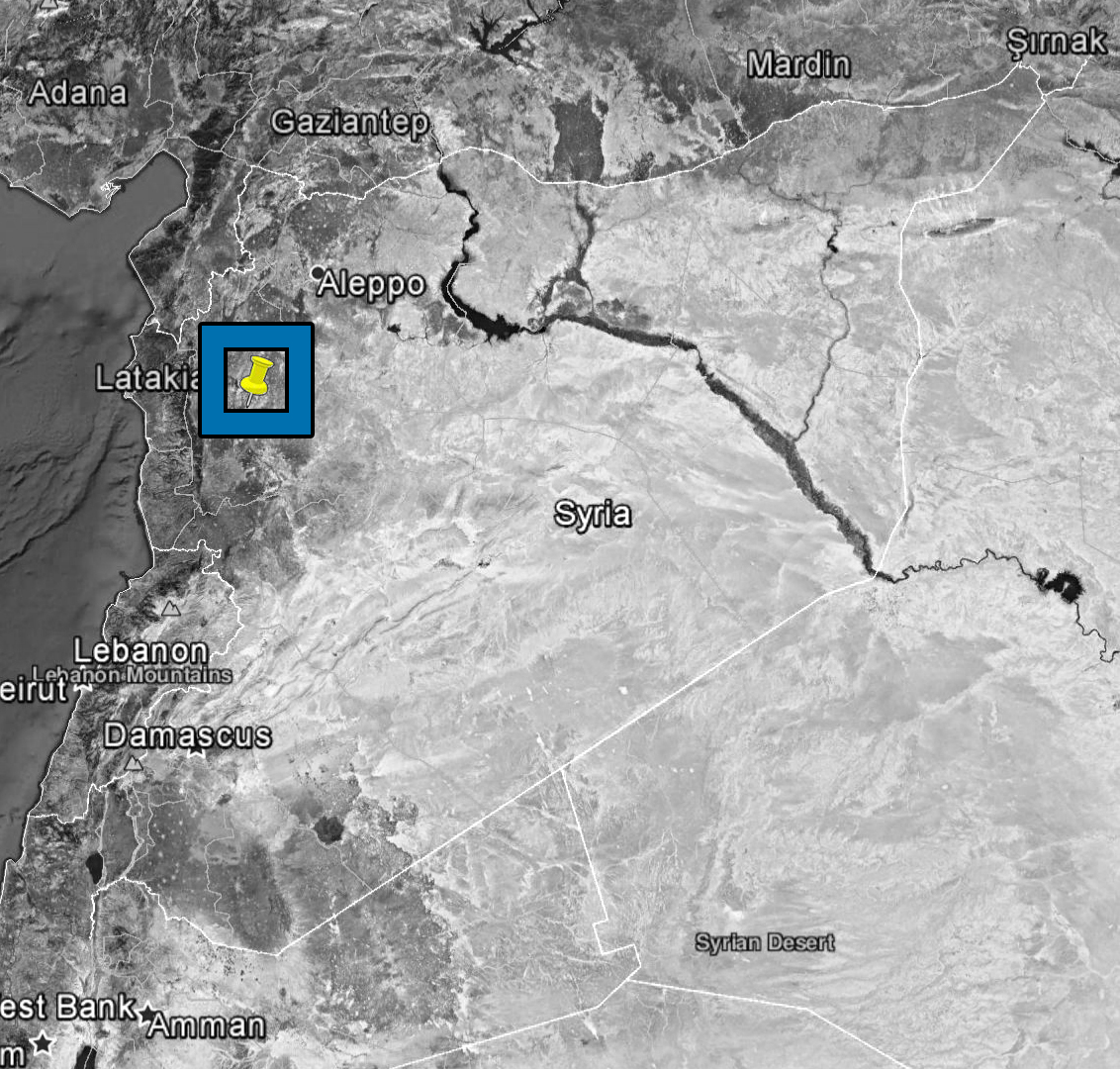
The blue square refers to the location of Khan Sheikhoun
Section 1: The Locations of the Rockets Loaded with Toxic Substances
Based on the research team’s inspection of the area, as well as testimonies of residents from the northern neighborhood, it is clear that the in the first attack, the rocket likely loaded with the greatest amount of toxic chemicals fell in the al-Sawam’e neighborhood that contains warehouses for storing grain. The projectile fell in the middle of the highway that separates the grain silos from a residential area full of stores. This rebuts the theory and allegations of media outlets close to the Russian and Syrian government that the rockets were targeting “chemical laboratories.” The other four other rockets fell hundreds of meters away from the first one.
According to testimonies from individuals in the southern neighborhoods where the second attack took place, these rockets also appeared to residents to have also had poisonous substances. After reviewing the weather forecast that day, however, the research team concluded that the wind’s north-south direction supported the hypothesis of the toxic gas dispersing mainly to the southern neighborhoods, causing many people to be injured. Given this conflicting account, there must be an international, independent, impartial, and transparent investigation to completely determine the facts of the attack and to determine the model of the rockets loaded with toxic chemicals, the number of rockets carrying toxic chemicals, as well as the type of the gas used that day.
Image illustrating the weather forecast and the movement of the wind on Tuesday morning, April 4, 2017 in the targeted area. The north-south wind explains why civilian were injured in the southern neighborhoods as well helping to explain why some individuals alleged that the later rocket strikes also contained toxic substances.
The first rocket that hit the al-Sawam’e neighborhood created a crater of 85cm deep and 160cm in diameter. It landed only 16m away from the residential houses and 18m away from grain silos. Whereas, the second projectile fell about 250m away from a residential house belong to (Ali Omar) and appeared to be a thermobaric weapon, according to the research team. Yet, no final conclusion has been made about whether the rocket contained chemicals.
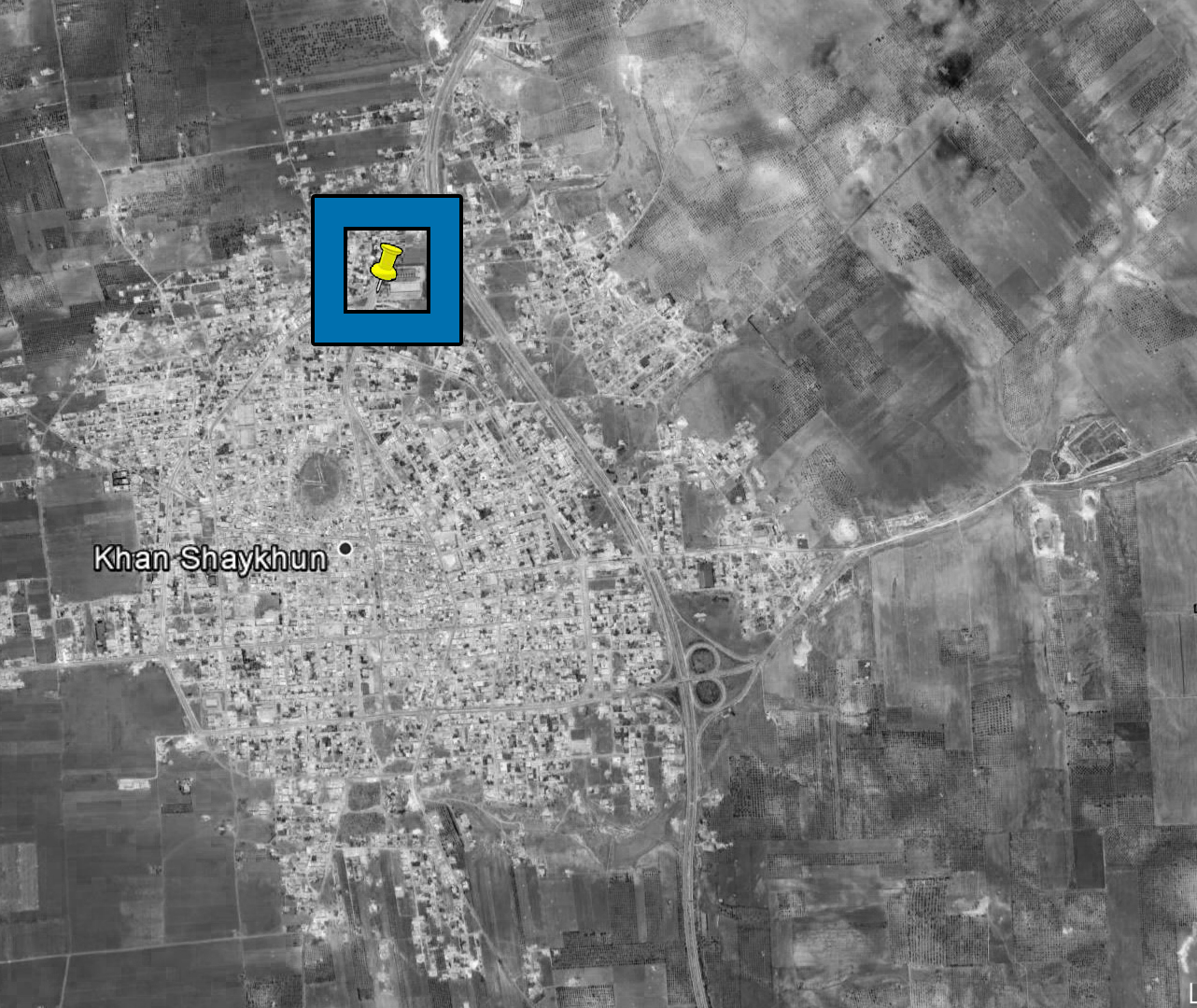
The blue square refers to the strike location of the first rocket loaded with toxic chemicals north of Khan Sheikhoun.
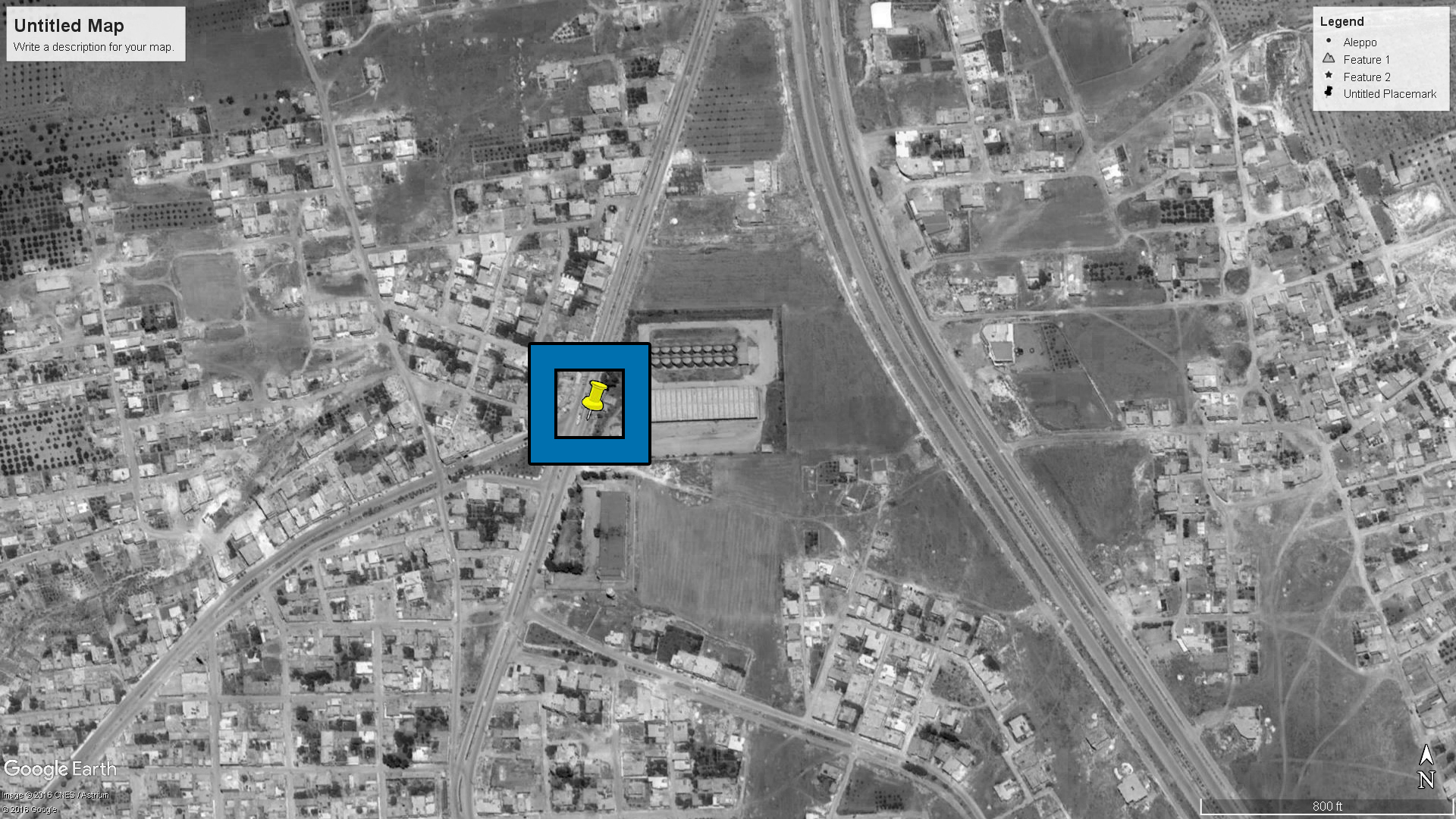
The blue square indicates the location of the specific coordinates of the first rocket.
Latitude: 35°26'59.71"N Longitude: 36°38'56.01"E
Othman al-Khder, born in 1983, a lawyer from Idlib province and a field researcher at Syrian Institute for Justice, testified[10] to the research team:
“The targeted locations included many places, not only one. There were many strikes and the distance among them was triangular, between 400 to 500m. One of the strikes was on the main highway opposite to the grain center, the second strike on the highway leading to the center of the city, and the third strike was in “Jadat al- Khamael” and caused a great destruction. However, it did not cause the same destruction thermobaric weapons usually cause.”
He added,
“The projectile that slammed on the highway- opposite to the grain center- was not the only projectile loaded with chemicals, the other three rockets in the first attack also had chemicals and slammed on the highway opposite to the grain center, the main street leading to the middle of the city, and on “Jadat al=Khamael.” This is according to the residents’ testimonies. We talk about several rockets loaded with toxic gases. Having examining the second strike’s location, a house in Jadat al-Khmael, pigeons were found choked without any trace of blood. People in the vicinity confirmed that as well. Even the next attack that followed the “Jadat al-Khamael” also contained chemicals.”
A video tape published by the Syrian Institute for Justice showed the first strike location as well as the geographical area that surrounds it. The video also showed a field researcher collecting samples of the soil.
Another video tape published by the Syrian Institute for Justice showed the poultry deaths due to April 4 attacks. It should be mentioned that this area is 200m away from the first strike location.

Image taken from the previously mentioned video tape.
One hour after the chemical attack, Syrian aircraft targeted the al-Rahma hospital that received the injured. According to Othman al-Kheder, the hospital contained the Civil Defense center.

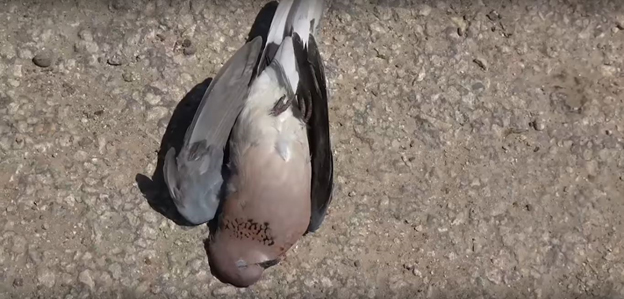
Image showing dead birds due to the spread of toxic substances.
Photo credit: Activist Video
The Syrians for Truth and Justice and Justice for Life Organization in Syria field research team created a video showing part of the geographical area surrounding the first strike location. However, it could not film the entire location with great accuracy given the dangerous security situation and the density of warplanes.
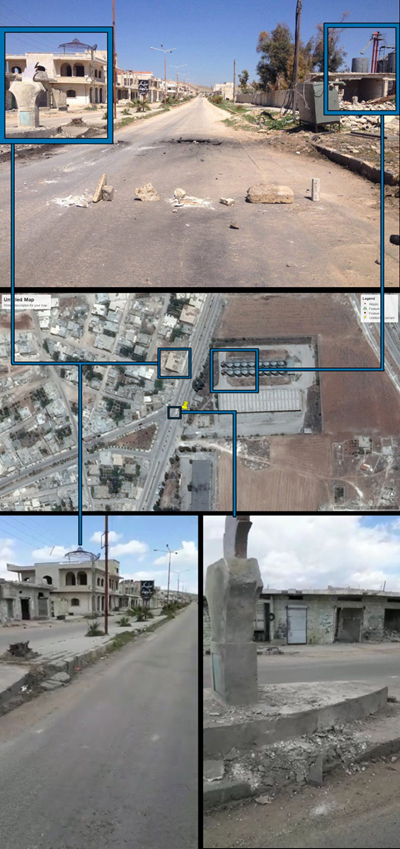
Image representing the first strike location with close-up images of specific effected areas.
Mohamed al-Saloum Al Abed[11], the activist who videotaped the moments immediately after the attack, stated he woke up that morning when he heard military aircraft hovering over the north-east side of Khan Sheikhoun. He saw it fly over the north-west part of the area, back again to the north, and then pass over to the south. As it passed, the aircraft fired four successive bombs; three of them fell on the north side while the fourth one fell on the west part in the city center.
He added,
“At first, I did not realize that it was a chemical attack, until one of the Civil Defense members went there and told us via a portable wireless set that he was falling asleep, feeling drowsy. Then, we lost contact with him. After that, we launched a warning call to civilians to tell them it was a chemical attack. Soon, we received names of scores of victims, being dead or injured, who suffered from asphyxiation and foam out of the mouth.”
Concerning the nature of explosions, al-Abd stated that the explosion, which contained a substance like oil, hit the northern neighborhood. He headed to the impact site after three hours had passed and, even then, he started to manifest symptoms of headache, cough and nasal irritation.
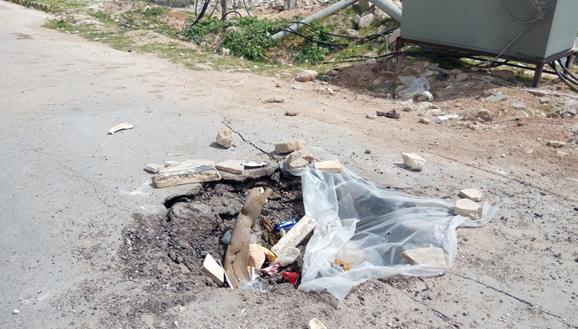
An image of the first strike location in the northern neighborhood where the rocket slammed in the middle of the highway that separates the grain silos and the residential areas. This first rocket, as cited by eyewitnesses and accounts of people interviewed, contained the largest amount of gas, resulting in symptoms that match the effects of Sarin toxic gas.
Photo credit: Mohamed al-Sloum al-Abd
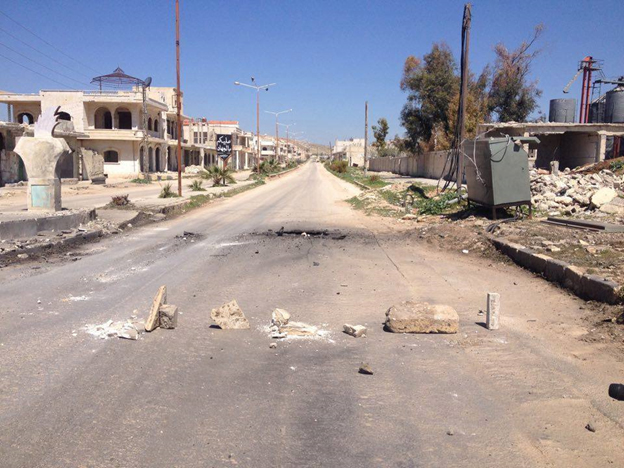
Image showing where the first strike, loaded with poisonous substances, occurred. As clearly shown, the grain silos are located on the right, whereas the residential areas are on the left.
Photo credit: Syrian Archive.

A panoramic image showing the site of the four rockets launched in the second attack. It should be recalled that news coverage did not claim the second attack contained chemical substances.
Image credit: Mohamed al-Saloum al-Abd
(This image represents an integration of three separate images.)


The hill in the middle of Khan Sheikhoun
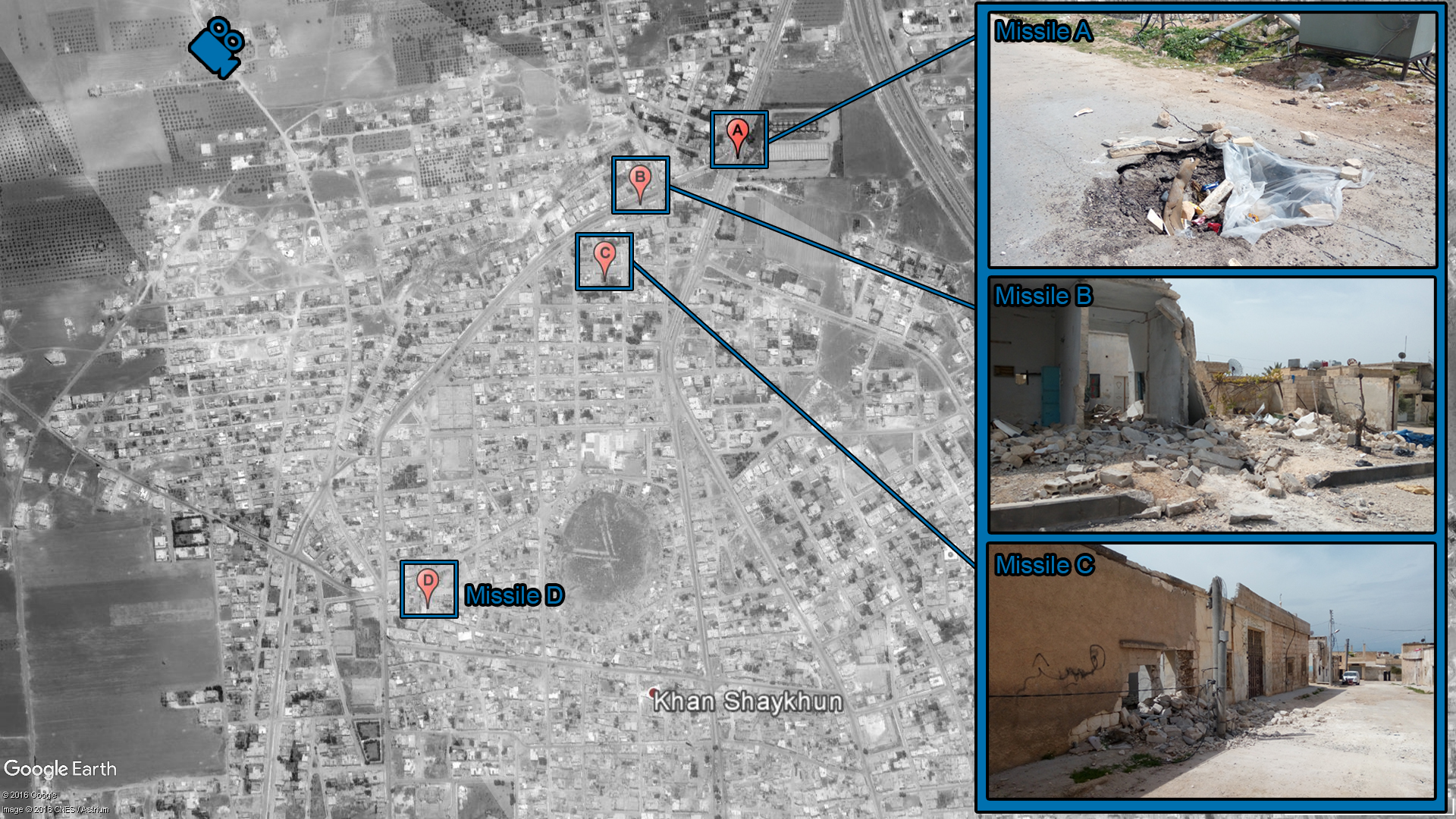
Image illustrating the impact sites on April 4, 2017.
Image A shows the first rocket location suspected to contain the largest amount of chemicals. Images B, C and D show the impact sites of the second missile attack.

Image A showing the first rocket strike location near the grain silos
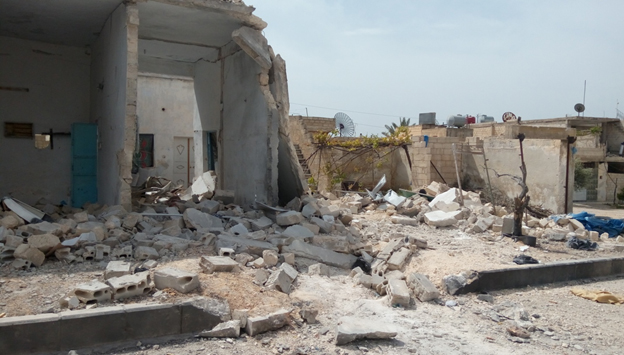
Image B showing the impact site of the second atack.

Image C showing another view of the second strike’s impact.
Section 2: The Details of the Attack
Every person interviewed by the field research team stressed that a military aircraft suspected to be a Syrian Sukhoi 22 (Su-22) conducted the attack. Neither the locals nor the activists realized that some rockets were loaded with chemicals until they received calls from individuals in the vicinity of the strike. As a consequence, the numbers of casualties and wounded were increased. The attacks occurred at 6:40 am, while most of the people were sleeping. The north-south wind likely moved the gas to other neighborhoods.
Mr. Rdwan al-Atrash, the Head of the Political Organization in Idlib province, stressed that targeted sites did not contain any military zones and stated that a Sukhoi 22 conducted the attack. He added:
“April 4, 2017, and at 6:30 am, the densely-populated neighborhood of al-Sawam’e, located in the north part of Khan Sheikhoun, was bombarded with Sarin gas. Then successive raids hit the city, caused scores of casualties, and wounded many more because of a lack of experience in dealing with cases like this. Locals thought that it was a thermobaric weapon or something else, but did not realize it was a chemical attack.
The incorrect understanding of the nature of the bomb, and the use of incorrect medications, led to even greater casualties. In addition, local medics hurried to save the injured. Yet once they touched the patients, the medics were injured as well. They thought it was a thermobaric weapon attack.
He added:
“Many injured people were transferred to field hospitals and medical centers in nearby towns as the city’s medical center (the cave center operated by the Civil Defense) was targeted directly and went out of service. Some of the injured were transferred to Turkey. The number of casualties was 90, and 550 injured.”
The activist Anas Thyab, the media official for the Civil Defense, stated that the first strike was near the grain silos. It did not cause an explosive sound like the others. In

